
theHotstar

theHotstar
Below is the excavation site of the Eanna district in the city of Uruk, ancient Sumer approx 3500 b.c. This is a thousand years before any pyramid. This is the cradle of civilisation, the city within it archaeologists credit with the creation of writing - cuneiform. The religious district of Uruk housed the temple of Inanna, a goddess called “the Queen of Heaven”. A building unearthed here, a different temple, one of peculiar architecture, shows writing wasn't the only creation there.
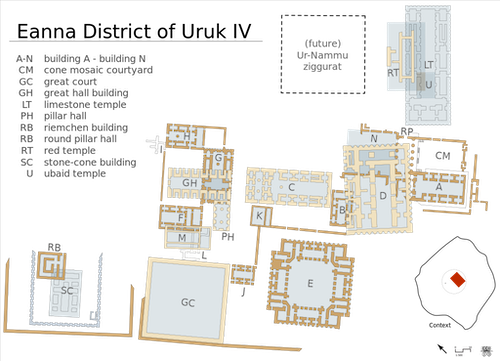
Building E is a 60m x 60m(approx) square with an inner 30m x 30m(approx) square courtyard.[0] Its outer dimensions are double its inner, meaning the inner dimension has been doubled, geometric and concentric. You'll also notice its four corners, or vertices, are perfectly oriented to the direction of a compass.

THE END OF PREHISTORY AND THE URUK PERIOD , Guillermo Algaze
The areas of these two squares are:
30mx30m = area 900m, 60mx60m = area 3600m, Ratio = 1:4
No height dimension can be given, but if this temple were a cube with an inner cube, the areas of the inner and outer cubes would be:
30mx30mx30m = area of 27000, 60mx60mx60m = area 216000, Ratio = 1:8
Both 27 and 216 are perfect cube numbers, and the ratio between them is also the perfect cube number 8. Which is to say, 216 can be made up of an octet of perfect cubes with a volume of 27. Which is to say geometrically, this temple has been designed to be perfect, entirely rational in conformation.
Plato the eugenicist writes in book 8 of his Republic regarding measurements of the gene pool:
“Now for divine begettings. there is a period comprehended by a perfect number, and for mortal by the first in which augmentations dominating and dominated when they have attained to three distances and four limits of the assimilating and the dissimilating, the waxing and the waning, render all things conversable and commensurable with one another, whereof a basal four-thirds wedded to the pempad yields two harmonies at the third augmentation, the one the product of equal factors taken one hundred times, the other of equal length one way but oblong, one dimension of a hundred numbers determined by the rational diameters of the pempad lacking one in each case, or of the irrational lacking two; the other dimension of a hundred cubes of the triad. And this entire geometrical number is determinative of this thing, of better and inferior births.”
The mathematicians claim Plato’s number is 216. I would not argue, only point out they haven’t a clue why. So let me show you the difference between knowledge and understanding.
A Sumerian cuneiform tablet(BM92698) excavated from Uruk, which archeologists date to around 2000 b.c., is a table of perfect cube numbers. The perfect cube numbers are the volumes of cubes whose outer dimensions are formed by a perfectly whole number, which when multiplied(length x width x height) give the cube’s volume as a perfectly whole number too. These are 10 in number then repeat into the higher powers:
1x1x1 = 1, 2x2x2 = 8, 3x3x3 = 27, 4x4x4 = 64, 5x5x5 = 125, 6x6x6 = 216, 7x7x7 = 343, 8x8x8 = 512, 9x9x9 = 729, 10x10x10 = 1000.

clay tablet BM92698 - sumerian cuneiform - perfect cube numbers - Uruk, circa 2000 b.c
Another tablet(Vat 8547) gives the formulas for finding the cube roots(line dimensions) from these perfect cube numbers. It lists formula’s for calculating line dimensions from those perfect cube volumes, 27 (= a cube with a length, width, and height of 3), 64 (= 4x4x4), 125 (= 5x5x5), 216 ( = 6x6x6) and so forth.

clay tablet VAT8547 cube root formulas - cuneiform - ?, circa 1800 b.c - Babylonian Mathematical Texts II-III, A Sachs
Now, for philosophical reasons of dire consequence, the first perfect cube number cannot actually be a cube with a volume of 1, as the ratio between the cube’s volume and its line dimension is irrational, and since this being in theory the smallest unit of measurement possible, you cannot drop down into a smaller one. And then cubes with the next six volumes of 2, 3, 4, 5, 6, and 7, all have irrational dimensions, so it cannot be these either.
A cube with a volume of 2 = cube line length dimensions of 1.25992104989487…into infinity
A cube with a volume of 3 = cube line length dimensions of 1.44224957030740…into infinity
A cube with a volume of 4 = cube line length dimensions of 1.58740105196819…into infinity
A cube with a volume of 5 = cube line length dimensions of 1.70997594667669…into infinity
A cube with a volume of 6 = cube line length dimensions of 1.81712059283214…into infinity
A cube with a volume of 7 = cube line length dimensions of 1.91293118277238…into infinity
A cube with a volume of 8 = cube line length dimensions of 2…perfect.
So you see, the smallest perfect cube must be a volume of 8 with a line length of 2. And this is the significance of the number 8. The volume of the smallest perfect cube that can replicate. Robert Graves will tell you this much.
“Seven was the sacred number of the week, governed by the Sun, the Moon and the five planets. But eight was sacred to the Sun in Babylonia, Egypt, and Arabia, because 8 is the symbol of reduplication—2x2x2. Hence the widely distributed royal sun-disc with an eight-armed cross on it.”
Because the first perfect cube number is 8 not 1, there are 9 perfect cubes in a pattern repeating into the higher orders infinitely.
8 - 27 - 64 - 125 - 216 - 343 - 512 -727 - 1000
8000 - 2700 - 6400 - 12500 - 21600 - 34300 - 51200 - 72700 - 100000, and so forth.
Which makes 216 the middle point between the lower and higher orders of this geometry.
Greeks even more cryptic than Plato the eugenicist called the number 8 the ogdoad, and said all things were made of it. And if you are unsure what is meant by this, look to the pixels rendered before your eyes in bytes, each of which are made of 8 bits. The ogdoad. Or think of the address space of octets which connect your computer to the server this site is hosted on, either through ipv4 or ipv6.
ipv4 = 8.8.8.8 (32 bits) 4 octets or ogdoads
ipv6 = 8.8.8.8.8.8.8.8.8.8.8.8.8.8.8.8 (128 bits) 16 ogdoads
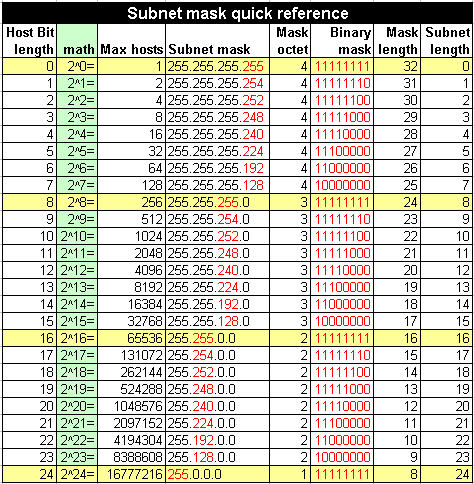
ivp4 subnet masking table
This cyperspace was conceived inside of the neXTcube, a black cube computer designed by Steve Jobs and used by CERN to develop the first http webserver, hosted and launched from it in 1992. The same year BlackRock was chiselled out of the blackstone.

ivp4 subnet masking table
Returning to Uruk 5500 year ago and the doubled square building. This was located in a temple district called the Kullaba, where another Sumerian goddess named Nisaba, also known as Ninirigal, nin(nan) meaning ‘lady of’ — a temple called the Irigal(Ibgal). Nisaba the lady of the Irigal. Initially this was a treasury used to store grain taxes, which made her an accounting goddess of writing, numbers, mathematics, general knowledge, which flourish to resemble the first references to secret or sacred knowledge regarding the design of temples. Nisaba was the architect. Her symbols were a writing tablet made of a deep blue gemstone called lapis lazuli and a golden stylus. Nisaba the architect, goddess of writing, the color of deep blue. Let me show you.
“You who speak as sweet as honey, whose name suits the mouth, longed-for husband of Inana, to whom Enki gave broad wisdom as a gift! Nisaba, the woman radiant with joy, the true woman, the scribe, the lady who knows everything, guides your fingers on the clay: she makes them put beautiful wedges on the tablets and adorns them with a golden stylus. Nisaba generously bestowed upon you the measuring rod, the surveyor's gleaming line, the yardstick, and the tablets which confer wisdom.”
“He raised the brick out of the [. . .] of the mould, and it looked as a holy crown worn by An. He lifted up the brick and went around among his people: it was like Utu's holy team tossing (?) their heads. The brick lifting its head toward the house was as if Nanna's cows were eager to be tethered in their pen. He put down the brick, entered the house and as if he himself were Nisaba knowing the inmost secrets (?) of numbers, he started setting down (?) the ground plan of the house. As if he were a young man building a house for the first time, sweet sleep never came into his eyes.”
“Thereupon, the [...] clay tablet, the pointed stylus of the assembly, the golden statue fashioned on a propitious day, beautiful Nanibgal, grown with a fair luxuriance, Nisaba, the lady of broad wisdom, opened for him her holy house of wisdom.”
The Irigal came to be known as the E-kur, or Duranki, a Sumerian and Akkadian term for axis mundi, which means center of the Earth. Not the core but an axis fixed to a theoretical device called a polestar. A pole around which the movement of things were turned to motion, but which itself remained motionless like the calm eye of a storm. The polestar became the ruler’s staff, held up by the ancient kings to represent their interconnectivity between these two polar realms.
The most well known polestar is the caduceus, a Greek term for the staff of Hermes which has its origin in a trio of gods from another Sumerian city called Lagash. The deification of the King of Lagash was through a god named Ninurta(Ningirsu), The god of Saturn(Kajamanu), a deification of the king usually symbolised as a pair of spread-eagle wings, or some other bird appendage of the king, giving him the appearance of a birdman.
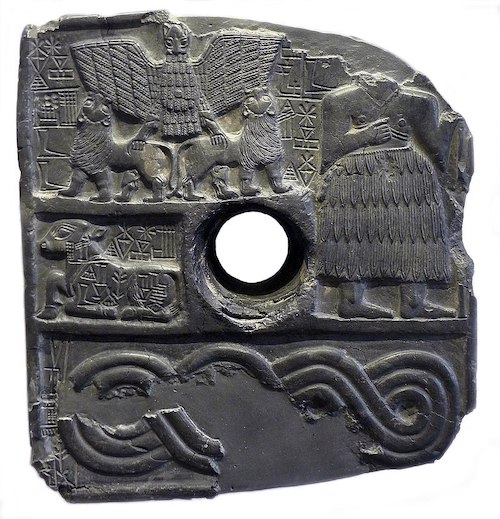
Votive relief of Dudu, a high priest of Ninurta, circa 2400 b.c
At least during the reign of a ruler named Gudea of Lagash, Ninurta had or was given two attendent deities. A snake servent named Ningishzida the serpent, and a pet dragon named Mushussu the serpent with wings. It is these who entwine around Ninurta’s staff in a figure of 8s. The double helix symbol used by the eugenicist James Watson to model DNA.

The Caduceus, 2100 b.c
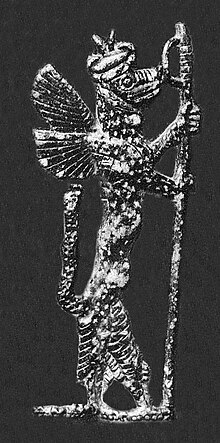
Mushussu, 2100 b.c
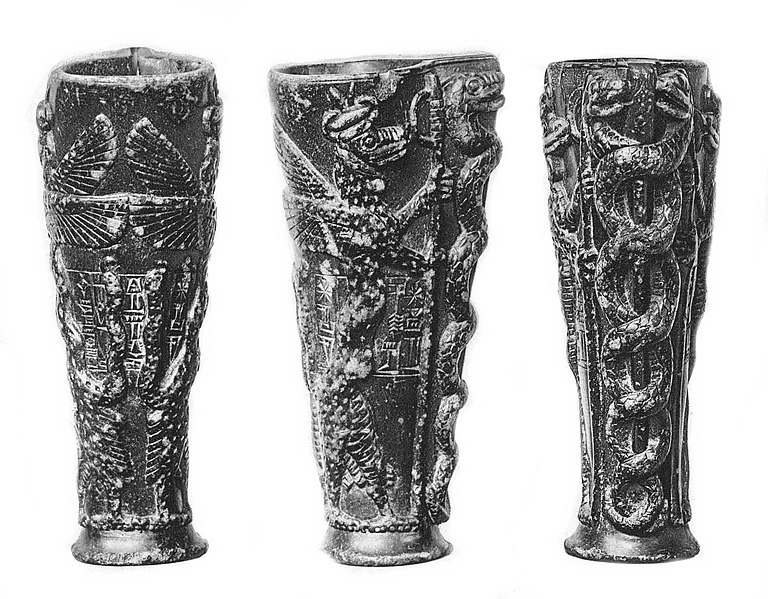
Libation vase of Gudea, circa 2100 b.c
The polestar was the ancients answer to the question of the prime mover. An axis on which all things turned, but which itself was motionless, removing any further need for an explanation as to what has brought motion to the axis itself. Philosophy having always been an effort to identify a primary cause of motion, or change to the reality we experience through our senses. The problem always having been, at least for those who claim such a thing can be found in a single thing, is then what causes the motion of it? The ancients thus concluded that whatever this thing was, it must then be motionless, since if something else gave motion to it, then it would be this other thing instead, and you are left back where you started. Think — a stick poked through an object you quickly twist then stop with a firm grip, leaving that object to spin perpetually around it. Then ignore the fact you had twisted the stick to cause this, and that was the primordial explanation for the primary cause of change in the universe. A motionless stick. Becase of this, in theory when the planets aligned, this stick could poke through all of them at once like the skewer of a shish kebab, and act as a conveyance between them, or a gateway to higher realms.
Not much has changed since. Imagine you light a firework and this big bang creates the universe. Then ignore the fact you lit it, and this is the modern secular explanation for the primary cause of change in the universe. For this reason heaven, the realm of the creator and house of god, has always been conceptualised as a motionless realm where nothing changes, and why depictions of it are ubiquitously calm and serene — orderly, or to atheists the most extreme form of motionlessness — nothingness. While its polar opposite realm — hell, is characterised as the opposite of this, always in rapid chaotic motion. This theme holds true for music too, the distinction heard between heavy metal and Christian rock.
A figure of 8s made of snakes, wrapped up around the polestar of Ninurta, god of Saturn, towards a motionless realm like the eye of a storm, turning all else around it into motion but itself, motionless. A realm symoblised by a cubic temple called the Irigal in Uruk, where a priesthood discovered both perfect cube geometry and irrational numbers. Well, according to the modern day Priests of NASA, who are about as trustworthy as their progenitors when it comes to expanding their budget:
“NASA's Cassini spacecraft has provided scientists the first close-up, visible-light views of a behemoth hurricane swirling around Saturn's north pole. In high-resolution pictures and video, scientists see the hurricane's eye is about 1,250 miles (2,000 kilometers) wide, 20 times larger than the average hurricane eye on Earth. Thin, bright clouds at the outer edge of the hurricane are traveling 330 mph(150 meters per second). The hurricane swirls inside a large, mysterious, six-sided weather pattern known as the hexagon.”
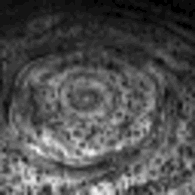
Vision of Saturn's Northpole by the priests of NASA

Clearer vision
These high-resolution 'images' NASA ‘filmed’ using:
“The Visible and Infrared Mapping Spectrometer (VIMS) collected both light that is visible to humans and infrared light of slightly longer wavelengths. It separated the light into its various wavelengths so scientists could learn about the composition of materials from which the light is reflected or emitted. Scientists used VIMS to determine the content and temperatures of atmospheres, rings and surfaces in the Saturn system. The instrument analyzed light but scientists also created images from its data, similar to a visible-light camera.”
Remember, almost all digital data is in the format of pythagorean ogdoads, or 8-bit bytes. All bytes can be controlled as each bit can be turned on or off like a light switch. This gives the priests of NASA absolute control over the visions they show you. See them explain it to you in their own words:
“If you looked at a ball of rubber bands the size of a soccerball, you’d have a hard time accurately observing all the kinds of rubber bands, what colors they were, or how strong they were. But if you took the ball apart and lined up the rubber bands in a row, you could learn all of the above.”
Better yet, let them show you their vision in the modern epic they commissioned: Interstellar Tesseract Scene
Christopher Nolan actually directed this scene inside a tesseract, within which we are fed the line, “Love tars love, my connection with Murph is quantifiable. It's the key!”. According to the priests of NASA, your experiences and emotions, all of them, are commensurate to units of 8 bits that can be communicated inter-dimensionally. A tesseract is a hypercube made up of 8 cubes, meant to represent the 4th dimension geometrically. Now, if you don't think we are talking about religion, here is a tesseract Salvador Dali unfolded in his Corpus Hypercubus to crucify Jesus Christ on.
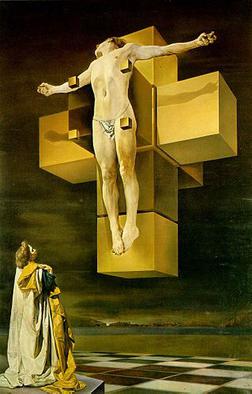
Crucifixion, Dali, 1954
This is called nuclear mysticism, an attempt to reimagine western religion alonglines that can once more be used to control the minds of a majority of the population, this time through data as most people are illerate in math, and those who aren’t are mostly illerate in everything else and easily controlled socially. In this way, using the major scientific breakthrough of the 20th century and pretending it’s related to bullshit interdimensional hypercube theory, religious prophesy can be reborn out of a split atom. This is why The Resurrection by Pericle Fazzini depicts Jesus Christ literally rising out of a nuclear crater all janus-faced with the head of a snake, and why this statue sits behind the pontiff's throne within the serpent temple the vatican calls an audience hall. This is Prometheus, a god of fire and the thief. Those who split the atom likened their creation to Prometheus stealing fire from the gods. And this is why Christopher Nolan inserted the reference in the opening sequence of his most recent social engineering project, Oppenheimer.
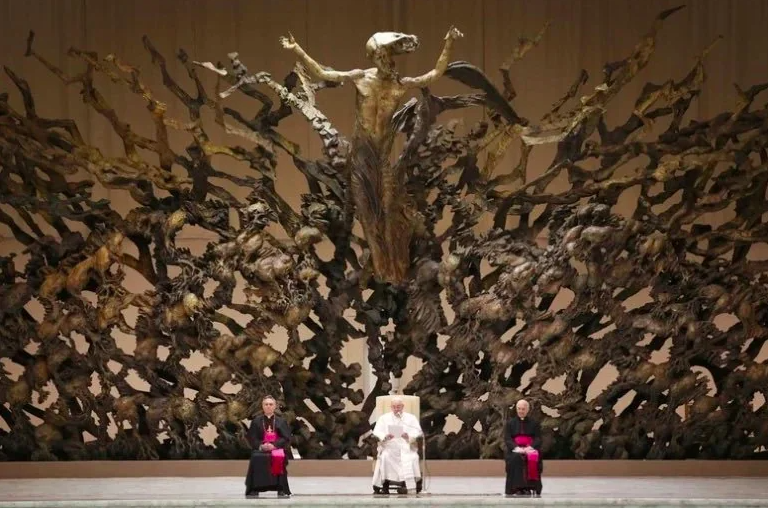
La Resurrezione, Pericle Fazzini, 1977, Paul VI Audience Hall,
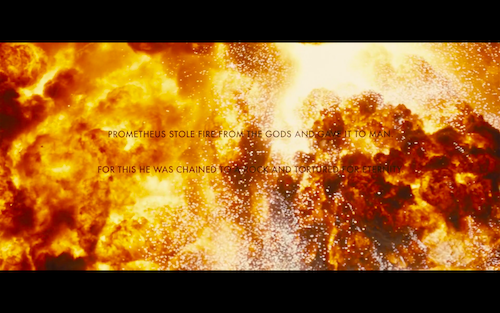
'Prometheus stole fire from the gods and gave it to man. For this, he was chained to a rock and tortured for eternity', Oppenheimer(2023) by Christopher Nolan
Why Prometheus? Well, every architect needs a builder.
Within the Irigal of Nisaba a god named Gibil was conceived, the Sumerian god of Fire, “whose mind is so vast that the gods, all of them, cannot fathom it”. Gibil wasn't quite the Sun though, this was Utu(Shamash). Gibil was a particular type of Sun under certain conditions.
“1 [...]
2 [...] the mountain/netherworld [...]
3 Gibil, born in the Irigal temple [...]
4 Born in the Irigal temple, a pure place [...]
5 Born in the Irigal temple, a holy place [...]
6 Born in [...]
7 [...]
8 [...]
9 Gibil, in the evening [...]
10 At night [...]
11 Utu does not look at the shrine
12 It is the [...] of Enlil! It is pure!
13 Gibil, who is gathered along with Suen in the high heavens [...]
14 It is the [...] of Enlil! It is pure!
15 He [...] in the great [...] of his father
16 The Anuna(Anunnaki) serve him
17 Gibil [...] in the oven of Enlil
18 The Anuna(Anunnaki) rejoice with him
19 [...]
20 [...]
21 Gibil […]”
Suen is another name for the Moon god Sin. When the Earth, Moon, and Sun align, the Sun is 'occulted' by the Moon and appears to us 'at night' or 'in the evening' of a solar eclipse. . .as a black sun. I'll say no more on this. 'The occult' leads people astray from what is in front of them. Hence its name and why those absorbed in its teachings can't clearly explain their ideas, so pretend they are secret so they don't have to. Rather, the explanations for most things seem to be found amongst the well-known texts well studied by academics, who never make anything of these because creativity is unscholarly.
GIBIL, who maintains the sharp point of the weapon,
Who creates artful works in the battle with Tiamat(chaos);
Who has broad wisdom, is accomplished in insight,
Whose mind is so vast that the gods, all of them, cannot fathom it.”
Gibil, Gi-bil-aga-mis, means the fire god commander, from whence came Gilgamesh.
“The name Gilgamish was originally written Gi-bil-aga-mis, and means “The fire god (Gibil) is a commander,” abbreviated to Gi-bil-ga-mis, and Gi(s)-bil-ga-mis, a form which by full labialization of b to u̯ was finally contracted to Gi-il-ga-mis. Throughout the new text the name is written with the abbreviation Gi(s), whereas the standard Assyrian text has consistently the writing GIS-ṬU-BAR. The latter method of writing the name is apparently cryptographic for Gis-bar-aga-(mis); the fire god Gibil has also the title Gis-bar.”
In the opening lines of the first creation epic, Gilgamesh is granted secret knowledge to build a flood wall around the religious district of Uruk.
Anu granted him the totality of knowledge of all.
He saw the Secret, discovered the Hidden,
he brought information of before the Flood.
He went on a distant journey, pushing himself to exhaustion,
but then was brought to peace.
He carved on a stone stela all of his toils,
and built the wall of Uruk-Haven,
the wall of the sacred Eanna Temple, the holy sanctuary.
Look at its wall which gleams like copper(?),
inspect its inner wall, the likes of which no one can equal!
Take hold of the threshold stone--it dates from ancient times!
Go close to the Eanna Temple, the residence of Ishtar,
such as no later king or man ever equaled!
Go up on the wall of Uruk and walk around,
examine its foundation, inspect its brickwork thoroughly.
Is not (even the core of) the brick structure made of kiln-fired brick,
and did not the Seven Sages themselves lay out its plans”
One league city, one league palm gardens, one league lowlands, the open area(?) of the Ishtar Temple,
three leagues and the open area(?) of Uruk it (the wall) encloses.
Find the copper tablet box,
open the ... of its lock of bronze,
undo the fastening of its secret opening.
Take and read out from the lapis lazuli tablet
how Gilgamesh went through every hardship.
Gilgamesh was given "the totality of knowledge of all". He saw "the Secret, discovered the Hidden" and builds the "the wall of Uruk-Haven", "the wall of the sacred Eanna Temple, the holy sanctuary", using "kiln-fired brick", and an "inner wall, the likes of which no one can equal!". Take hold of the threshold stone--it dates from ancient times!, "Find the copper tablet box","Take and read out from the lapis lazuli tablet", what Gilgamesh is told by the eighth king of Shuruppak.
“Utanapishtim spoke to Gilgamesh, saying:
I will reveal to you, Gilgamesh, a thing that is hidden,
a secret of the gods I will tell you!
Shuruppak, a city that you surely know,
situated on the banks of the Euphrates,
that city was very old, and there were gods inside it.
The hearts of the Great Gods moved them to inflict the Flood.
Their Father Anu uttered the oath (of secrecy),
Valiant Enlil was their Adviser,
Ninurta was their Chamberlain,
Ennugi was their Minister of Canals.
Ea, the Clever Prince(?), was under oath with them
so he repeated their talk to the reed house:
'Reed house, reed house! Wall, wall!
O man of Shuruppak, son of Ubartutu:
Tear down the house and build a boat!
Abandon wealth and seek living beings!
Spurn possessions and keep alive living beings!
Make all living beings go up into the boat.
The boat which you are to build,
its dimensions must measure equal to each other:
its length must correspond to its width.
Roof it over like the Apsu.”
[. . .]
“its walls were each 10 times 12 cubits in height, the sides of its top were of equal length, 10 times It cubits each. I laid out its (interior) structure and drew a picture of it (?). I provided it with six decks, thus dividing it into seven (levels). The inside of it I divided into nine (compartments).”
A boat with the geometry of a 120 x 120 x 120 cube. The unit of measurement given is cubits. A Sumerian cubit is 20 inches. 120 cubits converted is thus 2400 inches, converted into meters is 60m. The same dimsensions as the Irigal in Uruk, the temple in which Gibil was conceived, 60mx60m, but now in three-dimensions of 60x60x60m with a volume of 216000 cubic meters. The perfect cube of 216 to the power of a thousand. the nuptial number of Plato the eugenicist.
As control of Mesopotamia passed from the Sumerians to the Akkadians onto the Amorite Babylonians, Gibil was shrouded beneath a number of different names, primarily the god Nuska. But passing into the 1st millennia b.c this god of the black sun was resurrected by the Chaldeans in Babylon as — and here’s where it gets interesting, a blackstone.
A 19th century French archaeologist reports to have found a reference to Gibil as ‘God of the Blackstone’ on a tablet belonging to the Chaldean priesthood, which as we shall learn, was really the priesthood of Uruk.

The truth table origin of the divine name elah-Gabal was revealed on the day Mr. Friedrich Delitzsch established that the name of the god Fire of the ancient pre-Semitic people of the Schoumers and Akkads, subsequently adopted by the Chaldeo-Babylonian religion of the Semitic period, that this name, although written bil-gi by virtue of a law of reversal of the order of characters in the orthograph of which we have a good number of examples, read Gibil, a word which in the Acadian language is well known as meaning "to burn", as a verb, and "fire", as a noun. The god Gibil of Chaldea is surely the god Gabal of Emesa, and this is not the only example we have of a non-Semitic and Acadian divine denomination, passing among purely Semitic peoples through the influence of Babylon. Everything comes together to prove the identity of the two characters.
As we showed in a previous dissertation, a denatured igneous notion is attached above all to aerolithic betyl, the object of divine worship. Also the luminous emerald of the temple of Melqarth in Tyre, which was considered a betyl of this kind, replaced the perpetual fire which was maintained, as a simulacrum, in the temple of same god in Gades. Specially to the conical stone is attached the idea of an emblem of fire, at the same time as that of a phallic symbol, two notions closely linked together, because the igneous principle is considered as that of the male generation. This is what Gesenius saw very well, and what the name 'hammân attests, “the burning, the igneous,” given among the Phoenicians and the Hebrews to the divine simulacrum formed of a conical stone. The shape of the cone is that of the flame. The aerolithic betyl or lightning stone falls from the sky in the middle of an igneous explosion; the conical mountain is often a volcano that vomits flames. And in all cases it is considered to be lifted by the push of the interior fire. Also the god Fire or Gibil is called, in a bilingual hymn, Acadian with interlinear Assyrian translation, "the strong one who lifts the steep mountains”
Before my eyes ia the copy of a still unpublished fragment of a cuneiform mythological tablet, belonging to a private collection, where we read:
AN TAQ MI = AN. BIL. GI The God of the Black Stone = The God Gibil.
It formally follows that in at least a few localities of Chaldea this god was worshiped under exactly the same form as the elah-Gabal of Emesa.
Now, this god of Fire, transplanted into Syria by the radiation of influence of the religious center of Babylon, was assimilated to the Sun, this is why we have no reason to be surprised, and is perfectly consistent with its essential nature and its conoriginal conception. The Gibil of Chaldea is not only the fire worshiped in its material reality, the god who resides in the flame of sacrifice and in that of the domestic hearth, it is also the cosmic fire [French to English translation]
The blackstone is what the historians call betyl or baetylus, black iron ore meteorites the Sumerians called An.bar, fire from heaven.
“O Gibil (the god of fire), …… the palace and hall, as he radiates great awesomeness, his countenance ……! O Nun-bar-ana, angry avenger (?) ……, bringing forth the great torch from the abzu, lifting his head with the noble divine powers!”
“Through the wool from a fair lamb and the wool from a fair kid, Gibil, the foremost, the right arm, lifting his head to heaven receives water from the holy teats of heaven.”
“Gibil made his hoe (al) raise its head towards the heavens -- he caused the hoe (al), sacred indeed, to be refined with fire. The Anuna were rejoicing (alhulhuledec)”
The Assyrians called it Amutu and gave it a value eight times that of gold.[7] The Akkadians called it Kisru, a meteorite which fell upon Gilgamesh.
"My mother, during my night I became strong and moved about among the heroes; And from the starry heaven a meteor of Anu fell upon me: I bore it and it grew heavy upon me, I became weak and its weight I could not endure. The land of Erech gathered about it. The heroes kissed its feet. It was raised up before me. They stood me up. I bore it and carried it to thee."
To smelt iron, temperatures of over 1250 degrees celsius are required. The method and technology, or techni, for achieving this threshold wasn’t invented until perhaps around 2000 b.c. But when a meteor made of iron ore passes through earth’s atmosphere, it is enflamed at around 1800 degrees, creating what is called meteoric iron. And this quasi-steel existed in iron smithed forms, such as royal daggers and beads, for around a millennium before a technique for smelting terrestrial iron did.
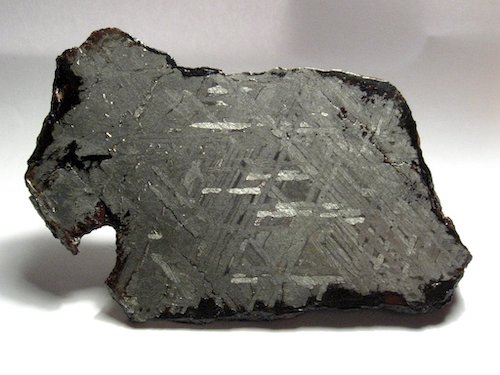
Meteoric iron inside of a blackstone meteorite
The blackstone was a literal alien technology created through its passage down from the heavens to earth. A technology literally passed through fire to humanity during the age of bronze, fortelling the one of iron to come. This is evolution through divine technology.
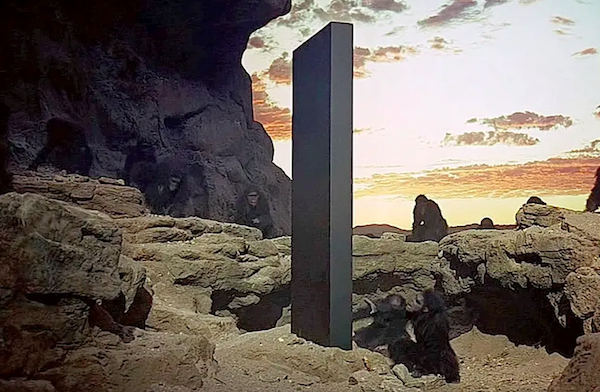
Kubrick pronounced the blackstone's intelligent design in his Space Odyssey by changing its coarse meteoric form to a polished rectangular slab. But its function is the same. A blackstone appears. A technological evolution occurs. A bone tool becomes a spaceship. The spaceship takes us to the moon. We discover another blackstone beckoning us to Jupiter. During this journey the next technological evolution occurs. Sentient artificial intelligence. We overcome this ordeal and arrive at Jupiter, where another blackstone takes us “beyond the infinite”. The advent in time between each blackstone and technological evolution is becoming shorter and shorter. Millions of years on earth. 18 months in space. Then only minutes within the rational space of an 8x8 chess board.[9]
Kubrick warns of the blackstone with shots of crescent horns closing in on it. This is the mark of Sin.

He warns of a betrayal by AI, which is really IBM, and strikes Saturn from the script, replacing it with Jupiter. He even returns us to earth without blowing it up as Arthur C. Clark does with nukes in the book.
Whoever oversees Nolan’s scripts revised all this in Interstellar. The destination is Saturn instead of Jupiter. AI is our ally who warns of our betrayal by fellow Mann. We do not save Earth, we abandon it for a completely artificial environment. The philosophy here is Promethean. Salvation from nature through technology. It is the philosophical project of the titans of industry like the Rockefeller family, who erected a statue to Prometheus in their plaza. The same family lurking behind the two most powerful American corporations, one in private equity called Blackstone, the other begot of it in public equity called BlackRock.

Statue of Prometheus in Rockefeller Plaza
Blackstone was founded by David Rockefeller’s right hand Peter Peterson, who succeeded him as chair of the CFR in 1985. That same year Peterson founded Blackstone with a former yale bonesmen named Stephen Schwarzman, who hired Larry Fink in 1988 to head a department spun-off as its own corporate entity in 1992 called BlackRock, which now sits atop the corporate pantheon. Every new technology being developed is now trapped like a ship in a bottle inside the same corporate framework with replaceable parts right up to the members of its board, all controlled through voting the proxy on stock held in the highly centralised custody of a few banks.


The historian says the first industrialists to smelt iron were the metalsmith guilds of the Caucasuses just above Anatolia, where we also find the proto-Promethean fire gods Pkharmat and Amirani.
“Although we must emphasize that many peoples in many places contributed to the knowledge of steelmaking, in the West the greatest contributions came from Armenia and from Noricum (Carinthia) in central Europe. We have already said that the origin of agriculture and of metal working are to be sought in the hilly zone where Anatolia is attached to Asia along the line from Alexandretta Gulf north to the Black Sea near the Caucasus Mountains. The beginnings of our kind of agriculture may lie near the southern end of this line, south of Lake Van; the early history of copper and bronze seems to lie on the same line but probably north of Lake Van, while the vital steps in the western use of iron seem to have happened even farther north, in Armenia itself. There, it would seem, the smelting of iron from its ores goes back to about 2000 B.C., and the carburizing of the resulting wrought iron was advancing by 1500 B.C. At that time the nearest civilised society was the Hittite, and it may be that the Hittite government tried to keep the developing innovation secret for some centuries. This would not be so difficult as we might imagine, for not only was the technique a difficult one that only an experienced metallurgist could understand, but the metal workers of this region had been very secretive about their earlier skills in copper metallurgy so that they could obtain high pay for the use of their skills, selling their products but not allowing their methods to be known. In fact, the early history of metallurgy is full of wandering groups or guilds of such workers who moved about, filling orders as they obtained them, and then moving on, with the tools of their trade on pack animals and the secrets of their skills kept locked in their heads, to be passed on only to their sons or apprentices.”
A Neo-Sumerian myth mentions the import of iron from the Zagros mountains in the late second millennia, during the reign of the third dynasty of Ur.
“they suspended them by his head in the mountain cave. They pushed into place at his head his axe whose metal was tin, imported from the Zubi mountains. They wrapped up by his chest his dagger of iron imported from the Gig (Black) mountains. His eyes -- irrigation ditches, because they are flooding with water -- holy Lugalbanda kept open, directed towards this.”
Ancient Ur was excavated during a 1920s a royal cemetery was unearthed. Among burial tombs of kings and queens and death pits full of their servants, who’d been ceremonially pick-axed in the head, had been fragments of a dagger made from meteoric iron.[12] The largest structure in the cemetery was a mausoleum belonging to a king named Shulgi, who ruled from 2100-2050. Shulgi's cylinder seal bore the name of Nuska, an Akkadian god of fire adapted from Gibil.
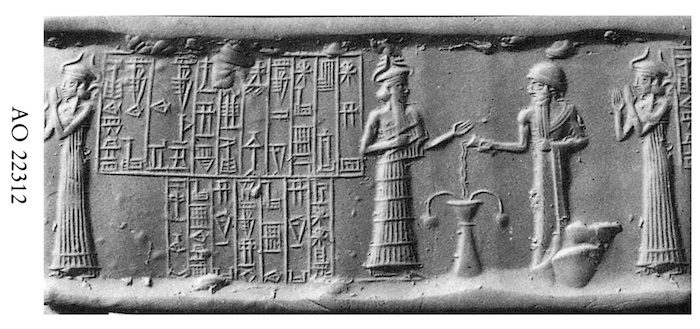
CDLI Seals 006346 (physical) (P226975), https://cdli.mpiwg-berlin.mpg.de/artifacts/226975, inscription reads:
“To Nuska, supreme minister of Enlil, his king, for the life of Shulgi, strong hero, King of Ur, King of Sumer and Akkad” [13]
A cuneiform text called Enlil and Ninlil refers to Nuska as "Master builder of the E-kur!”.[14] Nuska also shared a temple with Gibil in the religious center of Nippur called the Emelamhus, or ‘house of awesome radiance’. Nuska was the personal deity of the first kings of Ur dynasty III, where meteoric iron daggers appear in both the royal tombs of Ur and mythology from that period.
Ur is controversially known as Ur of the Chaldees, a supposed city of origin for the Chaldeans prior to their move into Babylon and establishment of the Neo-Babylonian empire. ’Ur of the Chaldees’ is given in the Hebrew bible as the birth place of Abraham, to whom all three ‘Abrahamic religions’ trace their origin.
Eventually, the guild secrets of Iron smelting got out and by 1200 b.c were pervasive. With this new technology came new empires, first of the Hitties and then the Assyrians. An Assyrian ruler named Ashurnasirpal II(900-850 b.c) described his methods:
“I stormed the mountain peaks and took them. In the midst of the mighty mountain I slaughtered them, and, with their blood, dyed the mountain red like wool. ... I carried off their spoil and their possessions. The heads of their warriors I cut off, and I formed them into a pillar over against their city. Their young men and maidens I burned in the fire. ... I flayed all the chief men who had revolted and I covered the pillar with their skins; some I walled up within the pillar; some I impaled upon the pillar on stakes. . . . Many within the border of my own land I flayed, and I spread their skins upon the walls, and I cut off the limbs of the royal officers who had rebelled. . . . Many captives from among them I burned with fire, and many I took as living captives. From some I cut off their noses, their ears, and their fingers, of many I put out the eyes. I made one pillar of the living, and another of heads, and I bound their heads to posts round about the city. Their young men and maidens I burned in the fire, the city I destroyed, I devastated, I burned it with fire and consumed it.”
There had been war before, but not like this. The pantheon of Sumerian and Akkadian gods took on extreme superstitions having to service the needs of the violent Assyrian regimes. Out of the carnage grew a new archetype of deity to reflect this darwinistic experience of human culture. unforgiving. pessimistic. cruel. punishing. Baal. Lords of insatiable bloodthrist passed to the Phoenicians, who would sacrifice their children to mollify.
The Neo-Babylonian empire was founded by a figure named Nabopolassar from a prominent family of Uruk, whose bloodline the historians call the Chaldean dynasty. Around 610 Nabopolassar in an alliance with Iranian Medes dynasty, forced the Assyrian eunuch king Sin-sar-iskun out of Babylon, and went on to sack the Assyrian capital, leaving Nabopolassar ruler of the former Assyrian empire. His son and successor Nabopolassar II was a high priest of Uruk under whose reign Babylon has been rebuilt. A new ziggurat called the Etemenanki was erected, of which Herodotus(484-425) gives the following specifications in his account of the new Babylon:
“In the middle of one division of the city stands the royal palace, surrounded by a high and strong wall; and in the middle of the other is still to this day the sacred enclosure of Zeus Belus, a square of four hundred and forty yards each way, with gates of bronze. In the center of this sacred enclosure a solid tower has been built, two hundred and twenty yards long and broad; a second tower rises from this and from it yet another, until at last there are eight. The way up them mounts spirally outside the height of the towers; about halfway up is a resting place, with seats for repose, where those who ascend sit down and rest. In the last tower there is a great shrine; and in it stands a great and well-covered couch, and a golden table nearby. But no image has been set up in the shrine, nor does any human creature lie there for the night, except one native woman, chosen from all women by the god, as the Chaldaeans say, who are priests of this god.”
Each layer of the ziggurat is double the square area of the terrace above it, and these terraces represented the Neo-Babylonian pantheon whittled down to five planets in addition to the moon and sun, making up 7 days all subservient to Jupiter, who was Marduk, the deification of the Babylonian king. On top of these 7 was eighth as well. The temple.
Moon = Sin
Sun = Shamash
Mercury = Nabu
Venus = Ishtar
Mars = Nergal
Jupiter = Marduk
Saturn = Ninib
Eighth Realm = Anu
The reason why “no image has been set up in the shrine,” is because it belonged to Anu, the father in heaven in the theological framework for monotheism developed by the Sumerian priesthood 1500 years earlier. A poem dated around 2100 called ‘the song of the hoe’ lays this out clearly in its first 7 lines.
“Not only did the lord make the world appear in its correct form(1) -- the lord who never changes the destinies which he determines(3): Enlil, who will make the human seed of the Land come forth from the earth -- and not only did he hasten to separate heaven from earth(2), and hasten to separate earth from heaven(2), but, in order to make it possible for humans to grow in 'Where Flesh Came Forth', he first suspended the axis of the world at Dur-an-ki(4).”
This is a philosophical doctrine with four key tenets:
(1) the reality we sense is correct.
(2) this reality is separate from the spiritual realm which we cannot sense, only know(be told).
(3) we do not have free will, everything is predetermined.
(4) the bridge between the reality we sense and the spiritual realm is the motionless axis that the creator “first suspended”, turning all else to motion around it.
This doctrine centralised the spiritual realm to within the mind, by shifting it from experience to knowledge, or from sensory reality to pure consciousness, or from the body to the mind, by detaching diety from the natural elements of motion people, including priests, have no control of, thus shifting it to some place beyond where they could be. The eighth realm.
This is, fundamentally speaking, the concept of duality or dualism, a term which became confused with 2-value logic or binary thinking, a property of rationalism to emerge from the theological separation between heaven and earth, since the earth was left to be made sense of rationally. The confusion occurred because the two are closely related. Prayer is meditation. Original sin is darwinism, as both believe the flesh is evil. Even the most ardent atheists like Sam Harris preach salvation through meditation. Pure mind. Detachement from sensory reality.
If something cannot be sensed only known, then what people are told of it cannot be contradicted by their lived experience. They can be told anything. Duality erased spiritual experience and made it meditative, allowing for knowledge to purely exist within the mind without any basis in reality. The lord could now work in mysterious ways.
Controlling minds is getting people to think in the literal when they should be thinking figurative, and in the figurative when they should be thinking literal. Literal means the thing I am experiencing is that thing. Figurative means the thing I am experiencing is actually not that thing but some other thing. Switching between the two perceptions, switches things on or off like little light bulbs within the skull. In this way minds can be turned towards or away from certain things, by convincing them the truth of such and such thing is to be found in one but not the other, in the literal or figurative perception of it, in any given instance.
Generally speaking, those of higher education are prone to being fooled by the figurative, while those of lower education prone to being fooled by the literal. Which is the difference between knowledge and experience. This is why the knowledgable tend to be ridiculously sceptical and mock others for being crackpots, while the experienced ridiculously credulous and mock others for being sheep. The soundness of mind is found between knowledge and experience, figurative and literal, within the ability to entertain an idea without accepting it, or accepting it only because it is useful not because it is true, allowing it to be dropped as soon as it becomes detrimental. But most can’t make do with this uncertainty, this malleability, and so concrete over the grass of their minds so they never have to mow it.
When Nabopolassar II conquered Judea only elite jewish families were taken to Babylon, no more than 5% of the population, as was the policy when the Babylonians conquered new territory. This is why Babylon was known as a babel of tongues and its ziggurat the tower of babel. The captivity ended after five decades of tutelage in 538, and soon there grew amongst the minds, an irresistible intrigue in temple designs.
Genesis 6 of the Holy bible repeats a part from the Gilgamesh epic, but gives the arc the more literal dimensions of a boat, and transfers the dimensions of the perfect cube into a more literal thing intended to be build, called the Holy of holies.
13 And God said unto Noah: 'The end of all flesh is come before Me; for the earth is filled with violence through them; and, behold, I will destroy them with the earth.
14 Make thee an ark of gopher wood; with rooms shalt thou make the ark, and shalt pitch it within and without with pitch.
15 And this is how thou shalt make it: the length of the ark three hundred cubits, the breadth of it fifty cubits, and the height of it thirty cubits.
16 A light shalt thou make to the ark, and to a cubit shalt thou finish it upward; and the door of the ark shalt thou set in the side thereof; with lower, second, and third stories shalt thou make it.
17 And I, behold, I do bring the flood of waters upon the earth, to destroy all flesh, wherein is the breath of life, from under heaven; every thing that is in the earth shall perish.
A flood comes. A single bloodline is left. The idea of genetic purity is born, particularly amongst the sons of Zadok. Genesis.[15]
If you haven’t read it, the Hebrew bible and by extension the old testament, is in large part a technical manual for temple construction, right down to the number of nails to be hammered into the floorboards.
The first set of instructions are given to Moses for the construction of a tabernacle with an inner partition of called The holy of holies, where a pair of stone tablets with commandments are to be kept within a chest called the ark of the covenant.
31 “You shall make a veil woven of blue, purple, and scarlet thread, and fine woven linen. It shall be woven with an artistic design of cherubim.
32 You shall hang it upon the four pillars of acacia wood overlaid with gold. Their hooks shall be gold, upon four sockets of silver.
33 And you shall hang the veil from the clasps. Then you shall bring the ark of the Testimony in there, behind the veil. The veil shall be a divider for you between the holy place and the Most Holy.
34 You shall put the mercy seat upon the ark of the Testimony in the Most Holy.
35 You shall set the table outside the veil, and the lampstand across from the table on the side of the tabernacle toward the south; and you shall put the table on the north side.”
Explicit dimensions aren't given but the theologians have blessed us with a consensus on the tabernacle’s dimensions. As you can see, the holy of holies is given as a 10 x 10 x 10 cubit cube, or the perfect cube with a volume of 1000.
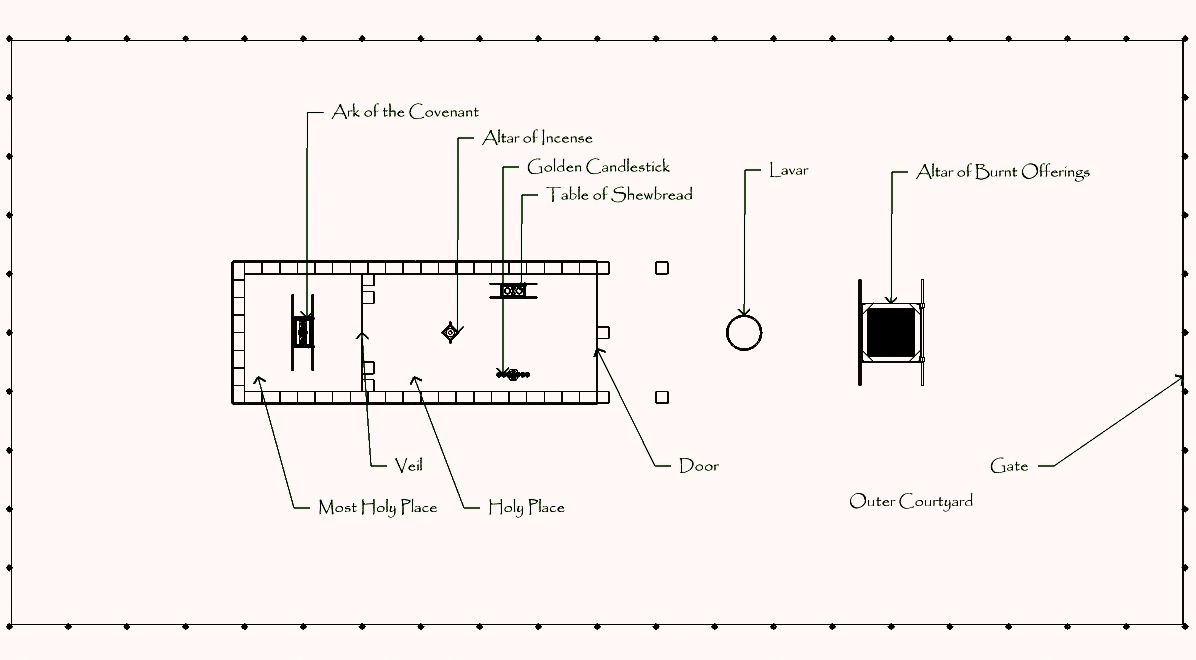
Moses tabernacle

tabernacle dimensions
In the book of Kings the architect gives Solomon instructions for a temple of the same basic layout as the tabernacle, only the dimensions of the holy of holies is now given as 20 x 20 x 20 cubits.
14 So Solomon built the temple and finished it.
15 And he built the inside walls of the temple with cedar boards; from the floor of the temple to the ceiling he paneled the inside with wood; and he covered the floor of the temple with planks of cypress.
16 Then he built the twenty-cubit room at the rear of the temple, from floor to ceiling, with cedar boards; he built it inside as the inner sanctuary, as the Most Holy Place. 17 And in front of it the temple sanctuary was forty cubits long.
18 The inside of the temple was cedar, carved with ornamental buds and open flowers. All was cedar; there was no stone to be seen.
19 And he prepared the inner sanctuary inside the temple, to set the ark of the covenant of the Lord there.
20 The inner sanctuary was twenty cubits long, twenty cubits wide, and twenty cubits high. He overlaid it with pure gold, and overlaid the altar of cedar.
21 So Solomon overlaid the inside of the temple with pure gold. He stretched gold chains across the front of the inner sanctuary, and overlaid it with gold.
22 The whole temple he overlaid with gold, until he had finished all the temple; also he overlaid with gold the entire altar that was by the inner sanctuary.
The dimensions of the holy of holies are repeated once more in 2 Chronicles.
8 And he made the Most Holy Place. Its length was according to the width of the house, twenty cubits, and its width twenty cubits. He overlaid it with six hundred talents of fine gold.
9 The weight of the nails was fifty shekels of gold; and he overlaid the upper area with gold.
10 In the Most Holy Place he made two cherubim, fashioned by carving, and overlaid them with gold.
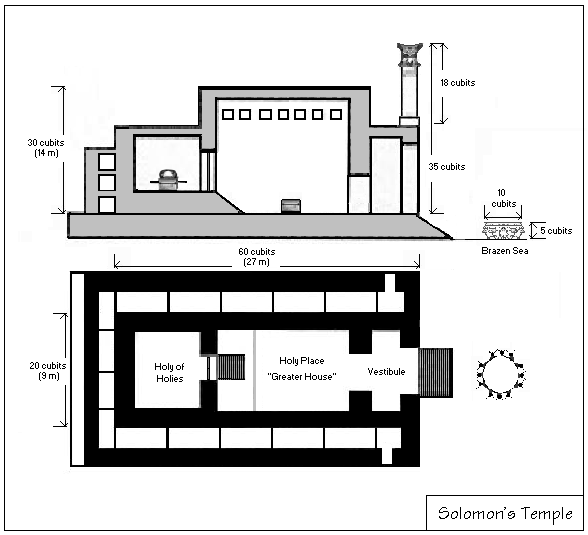
Solomon's temple
The holy of holies doubles from the tabernacle to the temple, becoming a perfect cube with the dimensions 20 x 20 x 20 and volume of 8000 cubits. Ahhh! but only the cubes dimensions have doubled, as its volume has gone from 1000 cubits in the tabernacle to now 8000 in the temple. A ratio of 1:8. The Greeks called this the Delian problem, a mathematical problem given to the people of Delos by the oracle of Delphi, who told them the solution to their problems was to be found in doubling the size of the alter in the temple of Apollo. The alter was a cube. Plutarch, a high priest of Apollo explains.
“That the god is a very great logician, his own responses show, for it, forsooth, is the business of a logician both to invent and to solve double-senses. For as Plato said when an oracle was given commanding the doubling (squaring) the cubical dimensions of the altar, not the linear, which latter any mason could have done by simple measurement. An oracle had been given commanding the doubling the size of the altar at Delos, which is a problem requiring the utmost skill in geometry, that it was not this the god required, but that he encouraged the Greeks should study geometry. In the same way, the god by giving forth responses with double meanings promotes and establishes Logic, as being indispensable for all such as intend to understand him rightly.”
The book of Kings states the Temple of Solomon was built by special masons from Gebal called the Gebalites or Giblites, whose identity undergo various transformations through the various translations of the reference to them. But that they were masons and from Gebal is clear.
32 And Solomon's builders and Hiram's builders and the Gebalites did fashion them, and prepared the timber and the stones to build the house.
— 1 Kings: 5, Hebrew
18 Thus Solomon’s workmen, and Hiram’s workmen, and the men of Gebal prepared the timber and the stone for the construction of the temple.
— 1 Kings: 5, New Catholic
18 And Solomon's builders and Hiram's builders did hew them, and the stonesquarers: so they prepared timber and stones to build the house.
— 1 Kings: 5, King James
18 And Solomon’s workmen, and the workmen of Hiram, and the masons hewed and prepared timber and stones for the building of the house.
— 1 Kings: 5, Geneva Translation
18 So Solomon’s builders, Hiram’s builders, and the Gebalites quarried them; and they prepared timber and stones to build the temple.
— 1 Kings: 5, New King James
18 and the builders of Solomon, and the builders of Hiram, and the Giblites hew, and prepare the wood and the stones to build the house.
— 1 Kings: 5, Young's Literal Translation
Gebal was a coastal Phoenician city later known as Byblos. The goddess there was called Baalat Gebal, ‘Lady of Gebal’, a patroness of shipbuilders, which according to the book of Ezekiel had been the profession of the Gebalites. Wisemen of Tyre who built arcs and temples designed like perfect cubes.
8 Inhabitants of Sidon and Arvad were your oarsmen; Your wise men, O Tyre, were in you; They became your pilots.
9 Elders of Gebal and its wise men, Were in you to caulk your seams; All the ships of the sea, and their oarsmen were in you, To market your merchandise.
The god of Gebal was El, El of Gebal.
“The true origin of the divine name elah-Gabal was revealed on the day Mr. Friedrich Delitzsch established that the name of the god Fire of the ancient pre-Semitic people of the Schoumers and Akkads, subsequently adopted by the Chaldeo-Babylonian religion of the Semitic period, that this name, although written bil-gi by virtue of a law of reversal of the order of characters in the orthograph of which we have a good number of examples, read Gibil, a word which in the Acadian language is well known as meaning "to burn", as a verb, and "fire", as a noun. The god Gibil of Chaldea is surely the god Gabal of Emesa, and this is not the only example we have of a non-Semitic and Acadian divine denomination, passing among purely Semitic peoples through the influence of Babylon. Everything comes together to prove the identity of the two characters.”
"No other etymology is in such good agreement with the idea held by the third-century Syrians of Emesa, concerning their god, Sol Elagabal. But the question remains whether this hypothesis really explains the form of the name. El-Gablil or El-Gebil would fit better than El-Gabal. These considerations, however, have only relative value, since the Syrian form of Elagabal was not handed down directly. This last etymology seems the most probable to R6ville. Furthermore, it does not exclude the other two. The root gabal from which the Arabic word for mountain derives, has given rise to the formation of verbal stems meaning either massive or exalted or to exalt. In Syriac and Arabic the verb gabal (or gebal) is used in the sense of form or manipulate, which explains the Hebrew meaning of complete, define, limit (cf. gebottl = border) and in Syriac form or create.
Thus, the sun god of the heights in the mythology of Canaan can be related to the god who is maker or creator. Although there is not a single positive fact available that can be accepted as conclusive evidence except the common symbol of the Black Stone, it is not improbable that the god Gibil of the Chaldeans and the god Gebal of the Hemenesi had, if not a common origin, at least original analogies, or that the cult of the former influenced that of the latter."
El of Gebal became Elagabal, the Syrian Sun god worshipped as a black meteorite by the Syrian priesthood based in the city of Emessa, where this god fused with the Roman sun god Sol to be introduced to Roman legionaries through the cult of Sol Invictus Elagabalus, which is where Roman soldiers picked up the salute of the rising sun. Yes, that infamous one. Elagabal was later introduced into Rome itself by the Emperor Elagabalus(318 a.d), the teenaged high priest of this god and scion of the Severan dynasty who took over the Empire at the beginning of the 4th century c.e.
Since the Freemasons fashion themselves as builders of Solomon’s temple, the capital G between their compass and square is no doubt a reference to Gebal, where the Crusaders would build the Castle of Gibelet, making Gibil the true god of their worship, the god of Gilgamesh, even if they themselves do not know this.

Returning to divine architecture. After the temple of Solomon had been destroyed the arcitect gets Cyrus the Great to rebuild it:
22 Now in the first year of Cyrus king of Persia, that the word of the Lord by the mouth of Jeremiah might be fulfilled, the Lord stirred up the spirit of Cyrus king of Persia, so that he made a proclamation throughout all his kingdom, and also put it in writing, saying,
23 Thus says Cyrus king of Persia: All the kingdoms of the earth the Lord God of heaven has given me. And He has commanded me to build Him a [i]house at Jerusalem which is in Judah. Who is among you of all His people? May the Lord his God be with him, and let him go up!
1 Then King Darius issued a decree, and a search was made in the archives, where the treasures were stored in Babylon.
2 And at Achmetha, in the palace that is in the province of Media, a scroll was found, and in it a record was written thus:
3 In the first year of King Cyrus, King Cyrus issued a decree concerning the house of God at Jerusalem: “Let the house be rebuilt, the place where they offered sacrifices; and let the foundations of it be firmly laid, its height sixty cubits and its width sixty cubits
4 with three rows of heavy stones and one row of new timber. Let the expenses be paid from the king’s treasury.
These are the only instructions given. 60x60 cubits. The temple’s construction happened under King Herod, who is said to have doubled the area of the temple mount. But the architect never gave Herod the designs for whatever temple he built there, and the site has never been excavated. Which puts Herod’s temple outside of the architects grand design, which makes sense as the architect of the Holy Bible clearly does not like King Herod. The designs for the next temple were rather given in a prophesy to an elite jew during Babylonian captivity named Ezekiel. Though these designs were for more than just a temple. They were for a kingdom partitioned into districts according to the purity of its occupants.
1 In the twenty-fifth year of our captivity, at the beginning of the year, on the tenth day of the month, in the fourteenth year after the city was captured, on the very same day the hand of the Lord was upon me; and He took me there.
2 In the visions of God He took me into the land of Israel and set me on a very high mountain; on it toward the south was something like the structure of a city.
3 He took me there, and behold, there was a man whose appearance was like the appearance of bronze. He had a line of flax and a measuring rod in his hand, and he stood in the gateway.
- Ezekiel: 40, New King James.
The holy of holies a given as 20 x 20 cubits with an area of 400 cubits.
3 Also he went inside and measured the doorposts, two cubits; and the entrance, six cubits high; and the width of the entrance, seven cubits.
4 He measured the length, twenty cubits; and the width, twenty cubits, beyond the sanctuary; and he said to me, “This is the Most Holy Place.”
— Ezekiel: 41, New King James
A temple distict is given as 500 x 500 cubits with an area of 250000 cubits.
15 Now when he had finished measuring the inner temple, he brought me out through the gateway that faces toward the east, and measured it all around.
16 He measured the east side with the measuring rod, five hundred rods by the measuring rod all around.
17 He measured the north side, five hundred rods by the measuring rod all around.
18 He measured the south side, five hundred rods by the measuring rod.
19 He came around to the west side and measured five hundred rods by the measuring rod.
20 He measured it on the four sides; it had a wall all around, five hundred cubits long and five hundred wide, to separate the holy areas from the common.
— Ezekiel: 42, New King James
A city is given as 4500 x 4500 cubits with an area of 20250000 cubits.
30 “These are the exits of the city. On the north side, measuring four thousand five hundred cubits
31 (the gates of the city shall be named after the tribes of Israel), the three gates northward: one gate for Reuben, one gate for Judah, and one gate for Levi;
32 on the east side, four thousand five hundred cubits, three gates: one gate for Joseph, one gate for Benjamin, and one gate for Dan;
33 on the south side, measuring four thousand five hundred cubits, three gates: one gate for Simeon, one gate for Issachar, and one gate for Zebulun;
34 on the west side, four thousand five hundred cubits with their three gates: one gate for Gad, one gate for Asher, and one gate for Naphtali.
35 All the way around shall be eighteen thousand cubits; and the name of the city from that day shall be: THE LORD IS THERE.”
- Ezekiel: 48, New King James
Further partitions of land then expand beyond this area, allocated to the various bloodlines.

A dead sea scroll called the Temple Scroll attempts to rewrite the temple of solomon along these lines.
Ezekiel’s prophesy was Christianised with a wink to Jesus and slipped into the end of the biblical canon by gnostics at the library of Alexandria, probably Origen, surely making the Book of Revelations one of the greatest psyops in human history. It was even copied by Marx in his prophesy of industrial capitalism. The aim is to make the means of achieving your ends the same for those whose interests are opposed to them. Just as marxists believed industrial capitalism would lead to the rise of the proletariat, evangelicals believe zionism will lead to the rise of Jesus Christ.
“The development of modern industry, therefore, cuts from under its feet the very foundation on which the bourgeoisie produces and appropriates products. What the bourgeoisie, therefore, produces, above all, are its own grave-diggers. Its fall and the victory of the proletariat are equally inevitable.”
The Book of Revelation has remained dormant for almost 2000 years, only having come to fruition in the past 70 through the creation of Israel. An evangelical was made speaker of the house recently(2023) despite being an neophyte to congress, and his main competitor for the position being near ideal as the former coach of a pederest wrestling program. The carrot is trustier than the stick.
1 Now I saw a new heaven and a new earth, for the first heaven and the first earth had passed away. Also there was no more sea.
2 Then I, John, saw the holy city, New Jerusalem, coming down out of heaven from God, prepared as a bride adorned for her husband.
3 And I heard a loud voice from heaven saying, “Behold, the tabernacle of God is with men, and He will dwell with them, and they shall be His people. God Himself will be with them and be their God.
4 And God will wipe away every tear from their eyes; there shall be no more death, nor sorrow, nor crying. There shall be no more pain, for the former things have passed away.”
[…]
9 Then one of the seven angels who had the seven bowls filled with the seven last plagues came to me and talked with me, saying, “Come, I will show you the bride, the Lamb’s wife.”
10 And he carried me away in the Spirit to a great and high mountain, and showed me the great city, the holy Jerusalem, descending out of heaven from God,
11 having the glory of God. Her light was like a most precious stone, like a jasper stone, clear as crystal.
12 Also she had a great and high wall with twelve gates, and twelve angels at the gates, and names written on them, which are the names of the twelve tribes of the children of Israel:
13 three gates on the east, three gates on the north, three gates on the south, and three gates on the west.
14 Now the wall of the city had twelve foundations, and on them were the names of the twelve apostles of the Lamb.
15 And he who talked with me had a gold reed to measure the city, its gates, and its wall.
16 The city is laid out as a square; its length is as great as its breadth. And he measured the city with the reed: twelve thousand furlongs. Its length, breadth, and height are equal.
17 Then he measured its wall: one hundred and forty-four cubits, according to the measure of a man, that is, of an angel.
[…]
22 But I saw no temple in it, for the Lord God Almighty and the Lamb are its temple.
23 The city had no need of the sun or of the moon to shine in it, for the glory of God illuminated it. The Lamb is its light.
24 And the nations of those who are saved shall walk in its light, and the kings of the earth bring their glory and honor into it.
25 Its gates shall not be shut at all by day (there shall be no night there).
26 And they shall bring the glory and the honor of the nations into it.
27 But there shall by no means enter it anything that defiles, or causes an abomination or a lie, but only those who are written in the Lamb’s Book of Life.
— Revelations 21, New King James
This is climax of the Holy Bible. New Jerusalem descending to earth as a giant 5280000 x 5280000 x 5280000 cubit cube.
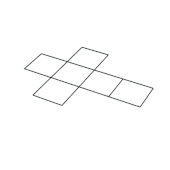

This is why our modern philosophers are mathematicians who cannot explain anything without the aid of a computer analogy. This is why there is an effort to convince us the reality we experience collectively through our sensory organs isn't real. And why we are now being told truth can only be known through numbers by a few, who can show it to us on a computer using geometry. They are trying to middle-man sensory reality.
[0] “Numerous buildings assignable to three superimposed but not always clearly delineable building phases and parts of a temenos wall separating those structures from the rest of the settlement were cleared in Level IV. The earliest structures in the level were a series of the now usual tripartite buildings (“Temples” A, B, F, G, and H), each roughly similar in scale to the earlier Stone Cone Mosaic Temple. What was new and significantly different at this time, however, was a very large square structure with recessed corners (ca. 57 m per side) of unique design assigned to Eanna IVb. Known as “Building E,” this structure has multiple external entrances leading to two symmetrical ranges of rooms and halls on each of its sides which, in turn, surround a large central square courtyard (ca. 31 m per side) that is also accessible through multiple points of entry (Fig. 4.1b).” THE END OF PREHISTORY AND THE URUK PERIOD, Guillermo Algaze. "In the heart of the city are two large temple complexes: the Anu (god of the sky) sanctuary, belonging originally to Kullaba, and the Eanna sanctuary, dedicated to Ishtar, known by scholars as the Mosaic Temple of Uruk, which rises to a height of 16 m on a square base measuring 60x60 m." - https://opus.lib.uts.edu.au/bitstream/10453/23385/5/02whole.pdf
[1] “Gibil is praised in conjunction with his birthplace, which is named as the AB-gal, to be read either as iri-gal or eš-gal. In the evening sky, Gibil joins the moon god Nanna in what is to be under-stood as either the “high heavens” or among the “high god(s),” depending of the interpretation of the phrase AN un-na, to be read as either an un-na, “highheaven,” perhaps a counterpart to the better attested location kur un-na, which Katz understands as a term for the netherworld, or diĝir unna, “highgod,” a designation that seems to occur, for example, in the context of Inana and Šukaletuda” - Studia Mesopotamica Jahrbuch für altorientalische Geschichte und Kultur, Herausgegeben von Manfried Dietrich Kai A. Metzler Hans Neumann, 2014
[2] ‘- https://www.academia.edu/85903330/ENUMA_ELISH, 2008, ENUMA ELISH - O Livro da Criação sumério, Nicole Sigaud, (“This version was written sometime in the 12th century BC in cuneiform on seven clay tablets. They were found in the middle 19th century in the ruins of the palace of Ashurbanipal in Nineveh. George Smith first published these texts in1876 as The Chaldean Genesis. ”, “The version presented here is a combination of several translations but issubstantially based on the translation of E. A. Speiser in Ancient Near EasternTexts Relating to the Old Testament, 3rd edition, edited by James Pritchard(Princeton, 1969), with modifications based on various other translations (forexample, the translation of L.W. King, The Seven Tablets of Creation, London1902).”)
[3] The Epic of Gilgamish by Stephen Langdon University of Pennsylvania The University Museum Publications of the Babylonian Section Vol. X No. 3 https://www.gutenberg.org/files/18897/18897-h/18897-h.htm#d0e166
[4] A hymn to Kusu: translation, The Electronic Text Corpus of Sumerian Literature, https://etcsl.orinst.ox.ac.uk/section4/tr4332.htm
[5] A hymn to Kusu: translation, The Electronic Text Corpus of Sumerian Literature, https://etcsl.orinst.ox.ac.uk/section4/tr4332.htm
[6] The song of the hoe: translation, The Electronic Text Corpus of Sumerian Literature, https://etcsl.orinst.ox.ac.uk/section5/tr554.htm
[7] ‘Meteors and Meteorites in the Ancient Near East’, Bjorkman, J. K., 1973, https://articles.adsabs.harvard.edu//full/1973Metic...8...91B/0000117.000.html
[8] An Old Babylonian Version of the Gilgamesh, Edited by Morris Jastrow, Translated by Albert T. Clay ‘https://uruk-warka.dk/Gilgamish/An%20Old%20Babylonian%20Version%20of%20the%20Gilgamesh%20Epic.pdf
[9] Hotel room ending in 2001: A Space Odyssey recreates Frank Poole vs. HAL 9000 chess moves, https://www.youtube.com/@HalldinAnton, 3 Oct 2010, https://www.youtube.com/watch?v=_WnX52GV4Zo
[10] ‘Weapon Systems and Political Stability: A History’, Caroll Quigley
[11] ‘Lugalbanda in the mountain cave’, circa 2000, https://etcsl.orinst.ox.ac.uk/section1/tr1821.htm
[12] ‘The Use of Meteoric Iron, T. A. Rickard, The Journal of the Royal Anthropological Institute of Great Britain and Ireland, Vol. 71, No. 1/2 (1941) - https://www.jstor.org/stable/2844401
[13] CDLI Seals 006346 (physical) (P226975), https://cdli.mpiwg-berlin.mpg.de/artifacts/226975 Administrative Cylinder seal excavated in Nippur (mod. Nuffar), dated to the Ur III (ca. 2100-2000 BC)
[14] Enlil and Ninlil: c.1.2.1, https://etcsl.orinst.ox.ac.uk/section1/b121.htm
[15] see https://www.familytreedna.com/groups/cohenbrazil/about/background